Fritsch's Quagga Photo (1864) taken in South Africa Has Been Rediscovered
By Branden Holmes and Jasper Hulshoff Pol. Published on 27 April 2024.
Artist Jasper Hulshoff Pol (website), with minor assistance from Branden Holmes, and confirmed by Dr. Peter Heywood, has rediscovered a stereophoto slide copy of a live Quagga photographed by Gustav Theodor Fritsch (1838-1927) in South Africa on 8 April 1864 (Fritsch, 1868).
Introduction
Africa is most often thought of as the continent that retains the largest proportion of its Late Pleistocene (c.126ka-11.7ka) megafauna (≥45kg), with the so-called "Big Five" (lion, leopard, rhinoceros, elephant, buffalo) only the tip of the biological iceberg. Alongside zebras, giraffes, Nile crocodiles, hartebeest, gnu (wildebeest), hippos, Greater kudus, Bongos, Great White sharks, Nile perch, Humpback whales, etc. etc. But palaeontological work over the last few decades has uncovered numerous large mammal (>5kg) extinctions, which are concentrated around the Late Pleistocene-Holocene border (13ka-6ka) (Faith, 2014). With the extinction rate increasing again after European colonisation, with the loss of taxa such as the Bluebuck (Hippotragus leucophaeus) (Hempel et al., 2024), the Cape warthog (Phacochoerus aethiopicus aethiopicus) (Grubb & d'Huart, 2010), the Bubal hartebeest (Alcelaphus buselaphus buselaphus) (IUCN SSC ASG, 2017) and the Senegalese giraffe (Giraffa camelopardalis senegalensis) (Petzold et al., 2020). One of the most famous of these latter disappearances is the Quagga (Equus quagga quagga), not least due to the long-term project (The Quagga Project) attempting to return its quasi-phenotype to southern African savannahs and grasslands (Parsons et al., 2007). It was last recorded in the wild in 1872 (Gippoliti et al., 2018), and the endling died in the Amsterdam Zoo on 12 August 1883 (Willoughby, 1966). It is one of relatively few extinct taxa for which 19th century photos of living individuals exist, and one of few to be the subject of multiple books (Barnaby, 1996; Green, 1996; Spreen, 2016; Heywood, 2022), and this latest photographic find emphasises the fact that research into the Quagga is very much ongoing.
The London Photos: All That Were Taken?
There are five surviving photos (see Appendix) of a Quagga (Equus quagga quagga) mare who resided in the London Zoo from 1851-1872, with her year of death seemingly coinciding with that of the last wild individual (Gippoliti et al., 2018). They were taken by Frank Haes (1864) and Frederick York (1870) (Heywood & Dietrich, 2021), but the last of them was only published more than a century later in 1991 (Huber, 1991, 1994). And even then, the details of the photographs have been made clearer by further research (Edwards, 1996; Fuller, 2013; Heywood & Dietrich, 2021). Today these five photos are now all freely available on the internet as they are in the public domain, including as part of the Wikipedia article on the subspecies. But it is sometimes stated that she was the only Quagga ever photographed alive (e.g. Huber, 1994; Wikipedia). However, it has been known by a handful of researchers that Gustav Theodor Fritsch (1838-1927), a medical doctor, took at least one (and possibly multiple) photos of a living specimen at the farm of Andrew Hudson Bain, 'Quaggafontein', on 8 April 1864, which was used to produce a photoxylograph (Fritsch, 1868; Barnaby, 1996; Heywood & Dietrich, 2021):
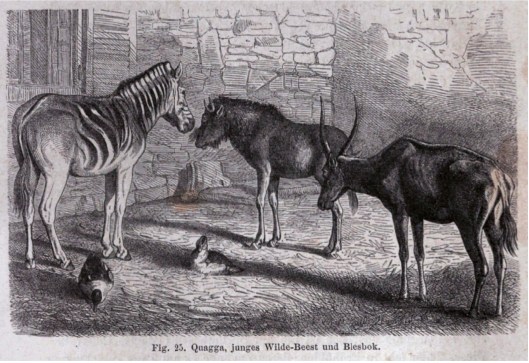
Above: a photoxylograph of a Quagga in South Africa. Reproduced from (Heywood & Dietrich, 2021), who reproduced it from (Fritsch, 1868).
The production of a photoxylograph involves the photochemical transfer of a photographic image onto a woodcut block prior to carving, and the fate of the original photograph/s is unknown (Heywood & Dietrich, 2021). The background has been noted as less photograph-like (Heywood & Dietrich, 2021), suggesting that multiple photographs may have been taken that were used as reference material for the stone wall and window shutters by the woodblock carver (Ibid., p. 8):
"Most probably, in our view, the wood engraving used to produce Figure 1 was reconstructed from other photographic images of these animals as the stone wall in the background with the window and shutters was drawn separately from other reference material and looks less ‘photographic’ than do the animals."
However, it must be noted that Jasper is of the opinion that the photoxylograph was produced from this stereophoto.
The Rediscovery of Fritsch's (1864) Photo
In December 2022, painter Jasper Hulshoff Pol noticed a listing for a slide of a Quagga in a July 1879 catalogue from Max Fritz (Fritz, 1879:8), and set about trying to track it down in case it was a 'new' photograph. Consequently, I sent him the Heywood & Dietrich (2021) paper about the photoxylograph, hoping that it might turn out to be a copy of the original photo. After reading the paper, Jasper searched for Gustav Fritsch and came across an eBay listing of a stereophoto of a zebra made by Gustav Fritsch. He purchased it, and when it arrived he noticed that it was the same image as Fritsch's photoxylograph, only mirrored due to the transfer process involved in photoxylography. I suggested that he contact Dr. Peter Heywood, who happily confirmed that the slide depicts the same Quagga as the photoxylograph (Peter Heywood, pers. comm. to Jasper Hulshoff Pol, December 2022):
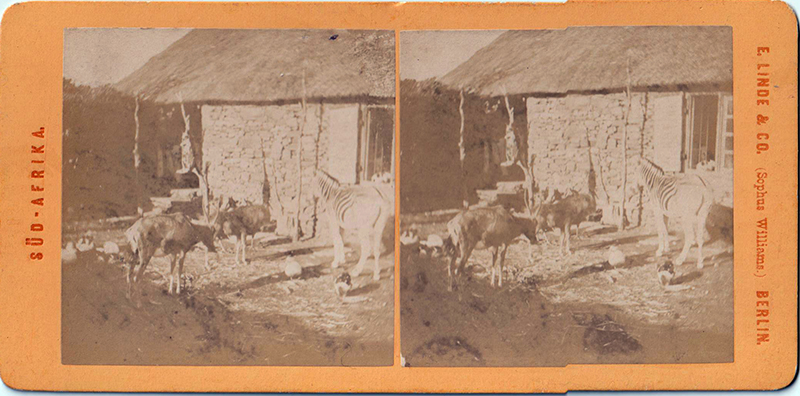
Above: the front of the slide. Kindly provided by Jasper Hulshoff Pol.
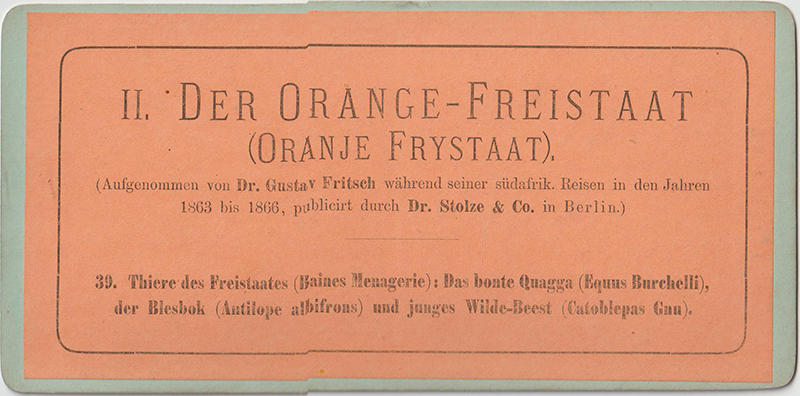
Above: the reverse of the slide. Kindly provided by Jasper Hulshoff Pol.
A Stereophoto: One Photo, Two Images
The original Max Fritz catalogue listing (Fritz, 1879:8) appears to be for a magic lantern slide for use in projection, which Jasper's slide copy is not. The original eBay listing for Jasper's slide stated that it was a stereophoto, implying that it was taken with a camera that uses two lenses centimetres apart to simulate our slightly different left and right eye positions (see Sleightholme et al., 2016:Fig. 4). When a stereophoto is viewed through a stereoscope it produces a three-dimensional image (Ibid.). This is consistent with some minor differences between the two images that can be seen below, showing that they are taken from slightly different angles: 1) The front legs are more open in the right image, 2) the white object on the ground between the rear legs is obscured more in the left image, 3) the shadow on the back of the right front leg is a different shape, and 4) the duck under the Quagga is in a different position relative to the front and back legs of the latter. Several other possible differences are harder to confidently distinguish given the blurrier quality of the left image.

Above: a side-by-side comparison of the two frames of the slide, with minor differences between them noticeable. Indicative of a stereophoto, in line with the original eBay listing.
Fritsch' Zebra, A True Quagga?
Heywood & Dietrich (2021) provide two lines of evidence to argue that the zebra Fritsch photographed on 8 April 1864 was a true Quagga and not a 'bonte' (striped) Quagga (i.e. Burchell's zebra, E. q. burchelli). The first was the degree of lack of stripes that goes beyond known cases of lesser-striped Burchell's zebra (i.e. no leg striping and reduced body striping), and the second was Fritsch's precision of language in describing the animal as a Quagga and not a bonte Quagga in full knowledge of the difference (Ibid.). Upon receiving a copy of the slide from Jasper via email, Dr. Heywood raised the fact that the slide lists the animal as a 'bonte Quagga' (i.e. well striped Burchell's zebra) and disagreed with this designation, reiterating the first line of argumentation made in his joint paper:
"Clearly, it's the same quagga illustrated in our paper and yet the description terms it "bonte" (striped) and names it as Equus burchelli. I have to disagree with this designation as leg stripes are absent and the body striping is reduced. In fact, the degree of body striping is similar to that in several museum specimens and illustrations labelled as "quagga.""
(Peter Heywood, pers. comm. to Jasper Hulshoff Pol, December 2022)
Conclusion
The evidence shows that Gustav Theodor Fritsch took a stereophoto (that produced two images from slightly different angles) of a Quagga on 8 April 1864 in South Africa. With Jasper's discovery of two images on a single stereoscopic slide bringing the total number of images of living Quaggas to at least eight or none: five photographs from London including at least one stereoview (resulting in at least six images), and one stereophoto (two images) and one photoxylograph (one image) (for nine total images), or, one stereophoto (two images) that were used to produce a photoxylographic version of them (for a total of eight images).
The fact that the reverse of the slide falsely identifies the zebra as a 'bonte Quagga' (Equus burchelli) may have prevented the significance of the slide from being recognised earlier. Although copies of such slides must now be relatively rare and not likely to be encountered very frequently. This raises the important possibility that other visual depictions of living Quaggas may await discovery/recognition, so long as the degree of lack of striping can be sufficienty seen to rule out lesser-striped examples of Burchell's zebra (Equus quagga burchelli).
Appendix: The five London photographs (1863-1870)
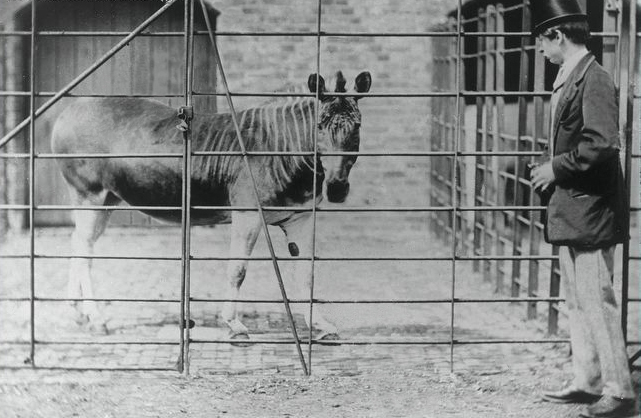
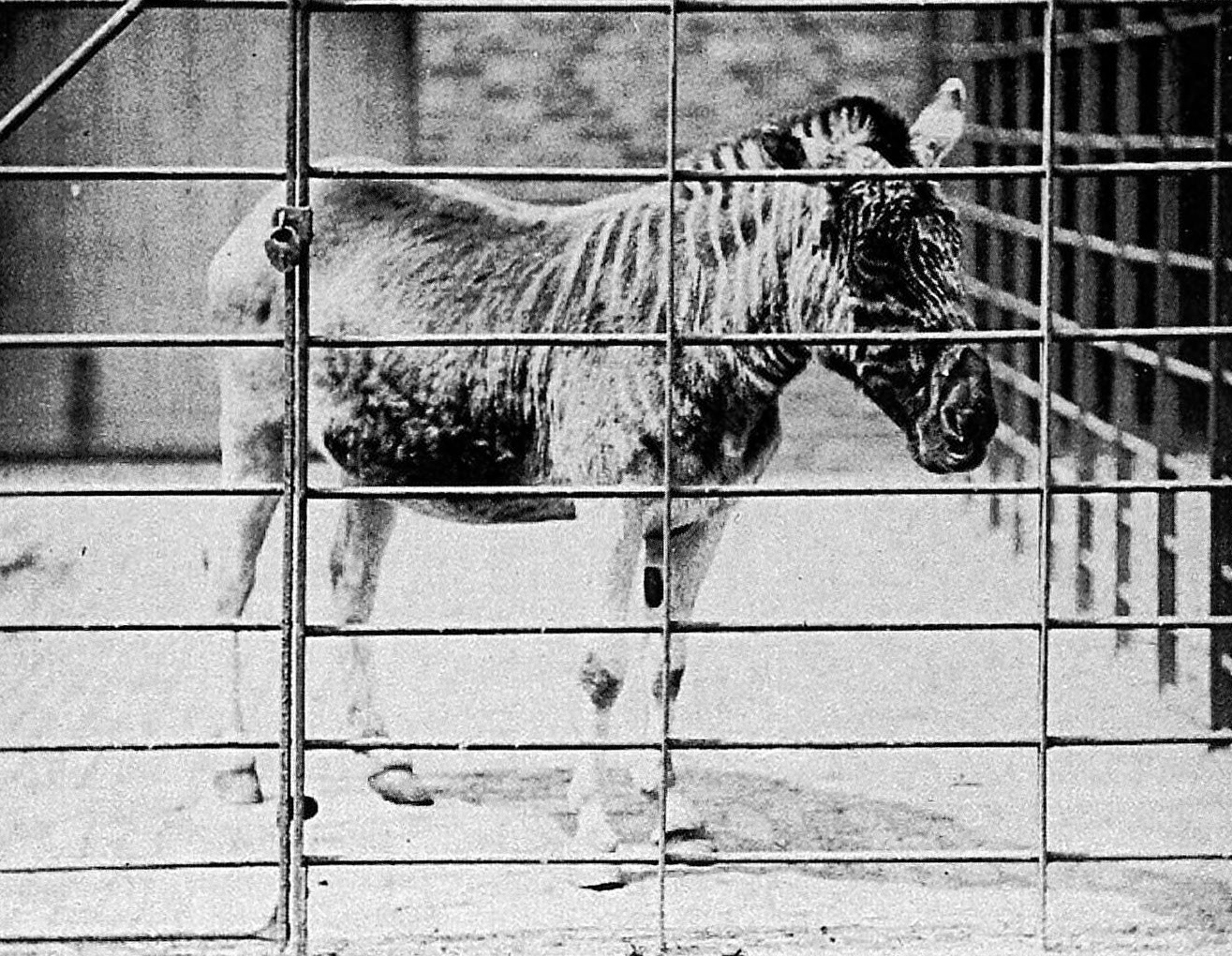
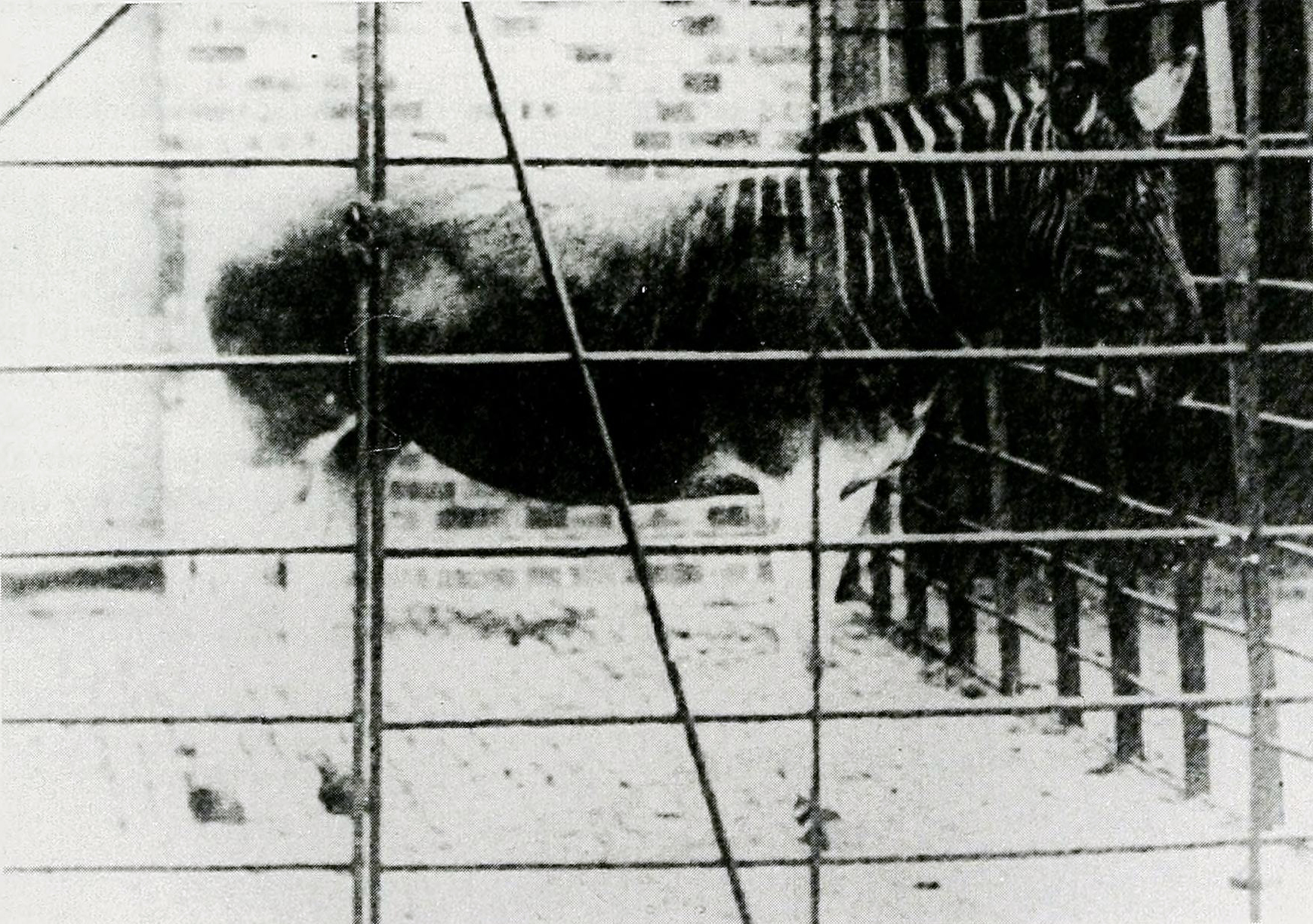
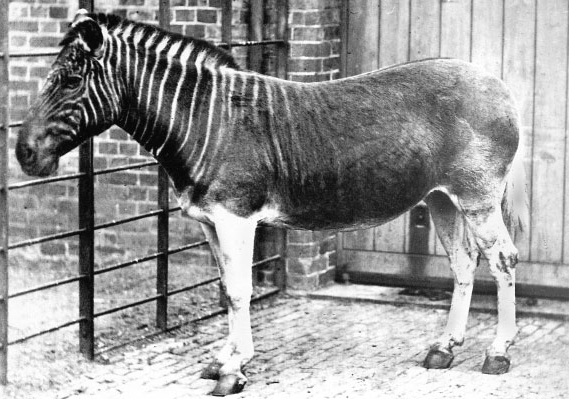
Above: one of two images from the stereoview (see here).
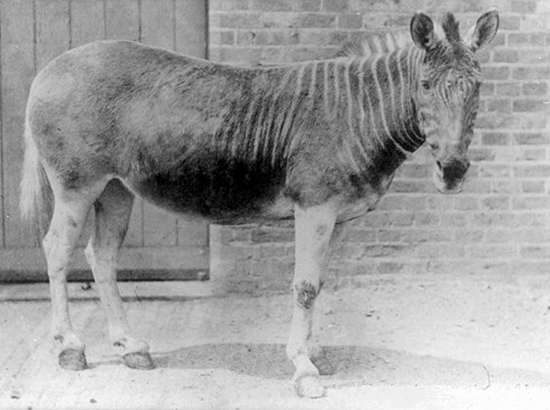
References:
Barnaby, David. (1996). Quaggas and Other Zebras. Plymouth: Bassett Publications. 114 pp.
Edwards, John. (1996). London Zoo from Old Photographs: 1852-1914. London: John Edwards. 240 pp.
Faith, J. Tyler. (2014). Late Pleistocene and Holocene mammal extinctions on continental Africa. Earth-Science Reviews 128: 105-121.
Fritsch, Gustav Theodor. (1868). Drei Jahre in Süd-Afrika. Reiseskizzen Nach Notizen des Tagebuchs zusammengestellt. Breslau (Ferdinand Hirt). 416 pp.
Fritz, Max. (1879). Das Scioptikon vervollkommneter Projectionsapparat für den Unterricht: Fünfte Auflage (fifth edition): Juli (July) 1879. Goerlitz, Silesia: Max Fritz.
Fuller, Errol. (2013). Lost Animals: Extinction and the Photographic Record. London: Bloomsbury Press. 256 pp.
Gippoliti, Spartaco, Cotterill, Fenton P. D., Zinner, Dietmar and Groves, Colin P. (2018). Impacts of taxonomic inertia for the conservation of African ungulate diversity:an overview. Biological Reviews 93(1): 115-130. https://doi.org/10.1111/brv.12335
Green, Tamara. (1996). The Quagga (The Extinct Species Collection). Gareth Stevens Pub. 24 pp.
Grubb, Peter and d'Huart, Jean-Pierre. (2010). Rediscovery of the Cape Warthog Phacochoerus aethiopicus: a review. Journal of East African Natural History 99(2): 77-102. https://doi.org/10.2982/028.099.0204
Hempel, Elisabeth, Faith, J. Tyler, Preick, Michaela et al. (2024). Colonial-driven extinction of the blue antelope despite genomic adaptation to low population size. Current Biology. https://doi.org/10.1016/j.cub.2024.03.051
Heywood, Peter. (2022). The Life, Extinction, and Rebreeding of Quagga Zebras: Significance for Conservation. Cambridge University Press. 242 pp.
Heywood, Peter and Dietrich, K. H. (2021). A quagga photographed in Africa (Mammalia, Perissodactyla, Equidae). Spixiana 44(2): 209-211.
Huber, Walter. (1991). Ein bisher unveröffentlichtes Foto eines lebenden Equus quagga quagga Gmelin, 1788 (Mammalia, Perissodactyla, Equidae). Spixiana 14(2): 235-236.
Huber, Walter. (1994). Dokumentation der fünf bekannten Lebendaufnahmen vom Quagga, Equus quagga quagga Gmelin, 1788 (Mammalia, Perissodactyla, Equidae). Spixiana 17(2): 193-199.
IUCN SSC Antelope Specialist Group. (2017). Alcelaphus buselaphus ssp. buselaphus. The IUCN Red List of Threatened Species 2017: e.T813A50181474. https://dx.doi.org/10.2305/IUCN.UK.2017-2.RLTS.T813A50181474.en. Accessed on 04 July 2022.
Parsons, Rochelle, Aldous-Mycock, Colleen and Perrin, Michael R. (2007). A genetic index for stripe-pattern reduction in the zebra: the quagga project. South African J. of Wildlife Research 37(2): 105-116. https://doi.org/10.3957/0379-4369-37.2.105
Petzold, Alice, Anne-Sophie Magnant, David Edderai, Bertrand Chardonnet, Jacques Rigoulet, Michel Saint-Jalme & Alexandre Hassanin. (2020). First insights into past biodiversity of giraffes based on mitochondrial sequences from museum specimens. European Journal of Taxonomy 703: 1-33.
Sleightholme, Stephen R., Campbell, Cameron R. and Kitchener, Andrew C. (2016). Frank Haes' thylacine. Australian Zoologist 38(2): 203-211. https://doi.org/10.7882/AZ.2016.022
Spreen, Reiner. (2016). Monument voor de quagga. Uitgeverij Fusilli. [in Dutch]
Willoughby, D. P. (1966). The vanished quagga. Natural History 75(2): 60-63.
